Panasonic DMR-HW100 Review
Panasonic DMR-HW100
Panasonic unleashes its first Freeview HD PVR, a 320GB, network-enabled machine with a whole host of funky features.

Verdict
Pros
- Lots of superb features
- Flexible recording and editing functionality
- Easy to use
- Versatile multimedia capabilities
- Smooth picture quality
Cons
- No built-in Wi-Fi
- Poor EPG
- Viera Cast's comparatively limited content
- No Scart output
- Hesitant video streaming
Key Specifications
- Review Price: £299.00
- 320GB hard-disk
- Twin Freeview HD tuners
- Viera Cast and Skype video calling
- DLNA media streaming
- 2D-to-3D conversion
We follow our review of Samsung’s debut Freeview HD PVR with Panasonic’s first stab at a standalone Freeview HDD recorder, the DMR-HW100. It’s actually a similar proposition to its Korean rival’s BD-DT7800, in that the usual range of Freeview recording features is backed up by fancy networking and internet functionality. Basically it does everything Panasonic’s Blu-ray/HDD recorders can do, without the Blu-ray bit. But if it’s hi-def disc playback you want, this model is launched alongside the DMR-PWT500, a Freeview HD PVR combined with a Blu-ray player.

The DMR-HW100’s 320GB hard-disk is housed within a plain yet attractive black casing, which looks pretty much identical to Panasonic’s Blu-ray players and recorders – even down to the flap that covers the entire front panel. Behind it lurks a USB port, SD card slot and channel change buttons, with blocked-off areas where the disc tray and CAM slot would have been. There’s a large display panel shining through the front flap giving the channel number or the time when in standby, plus a couple of LEDs next to it indicate which tuners are currently recording.
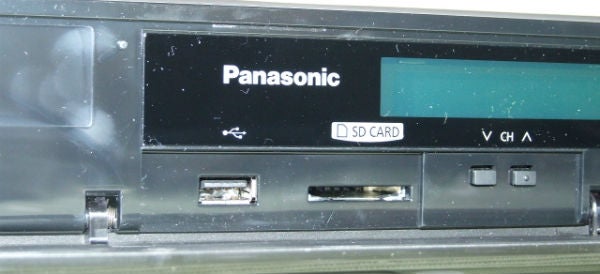
On the back you’ll find HDMI, optical digital audio and analogue stereo outputs, an Ethernet port, RF in/out and a second USB port that can be used to connect a wireless LAN adapter or a communication camera when using the built-in Skype functionality. Again it’s slightly disappointing to see that Scart output has been overlooked, as it means you can’t make copies on external recorders.
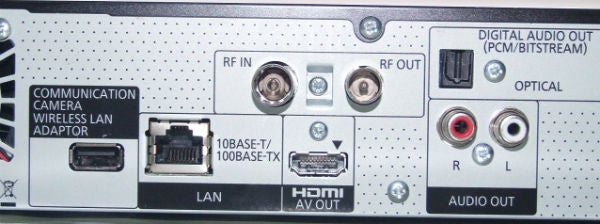
The DMR-HW100 is equipped with a 320GB hard-disk drive, which is relatively small in these days of 500GB and 1TB capacities, although the 79 hours of HD recording time (or 154 hours of SD) it offers might be enough for you. There are also two DVB-T2 tuners on board, which unlike Samsung’s BD-DT7800 allow you to record two channels simultaneously, or watch one channel while recording another.
Interestingly the DMR-HW100 is even ready to record 3D channels if and when they make their way to Freeview. For the time being though, you can take advantage of the unit’s built-in conversion and turn any 2D programme into 3D, even the news if you’re that way inclined. You also have access to the same range of 3D image tweaks found on Panasonic’s Blu-ray players including the Marmite-like ‘screen frame’ feature – you’ll either love or hate the diffused border it adds to the edge of the picture.
Another obvious highlight is this unit’s DLNA certification, which means you can stream media content from Windows 7 PCs and other devices on your network. You can also access recordings, AVCHD videos and JPEG photos stored on the HW100’s hard-disk on other client devices.
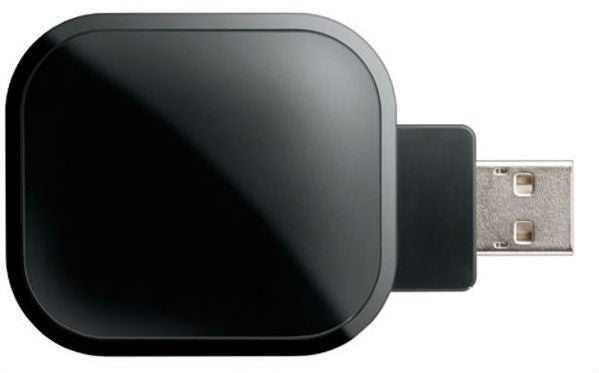
With Panasonic’s optional DY-WL10 wireless LAN adapter (above) connected, the DMR-HW100 streamed AVCHD, WMV, DivX and AVI files over our 802.11n network, although it had to think long and hard about playing AVCHD and DivX files beforehand and then stuttered during playback. MP3s and WMAs played with no problems.
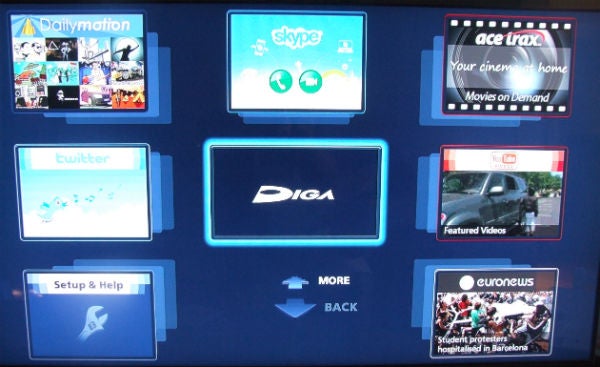
If that little lot isn’t enough content to keep you entertained, you can also dip into Viera Cast, which offers a range of sites including YouTube, Dailymotion, Twitter, Acetrax movies-on-demand, Picasa and other less UK-relevant sites like L’Equipe, Bild.de and Tagesschau. You also get weather and stock market updates. The selection isn’t a patch on Sony or Samsung’s equivalent web services but it is boosted by the inclusion of Skype, which allows you to make video calls using the optional (and rather expensive) TY-CC10 camera.

You can play DivX, MKV, JPEG, MP3 and WMA from USB devices, plus AVCHD and JPEG from SD cards. You can even copy music, videos and photos from SD cards or USB devices onto the hard-disk, turning into a sort of media jukebox.
You can play AVCHD videos filmed on a 3D camcorder through the SD card slot (which accepts SD, SDHC and SDXC cards) as well as MPO 3D images.
Finally there’s a bunch of five picture presets hidden in the Playback Menu, as well as other picture modes like HD Optimizer, Chroma Process, Detail Clarity and Super Resolution. There’s also a Dialogue Enhancer setting for audio.
The DMR-HW100 boasts a convenient range of editing features. Hit the Option key when browsing your recordings in the Direct Navigator and you’ll see an ‘Edit’ option. The subsequent submenu lets you delete part of the recording, divide it up or change the thumbnail or name.
Not all PVRs offer this level of editing functionality, and it could come in handy if you’re violently allergic to adverts or simply want to tidily chop off the ‘padding’ before and after a programme. It’s extremely easy to do, thanks to a friendly interface that plays the recording in a small screen and allows you to set start and end points with minimal fuss, plus the resulting edits are accurate.
Freeview recording functionality is as comprehensive as it gets. Series recording, Guide Link, split programme recording, on-screen alerts, rewind/pause live TV – you name it, this deck does it. And while watching a programme you can hit the i button and a handy on-screen banner shows you the key details. You can also check what’s on any channel, but it’s limited to ‘now and next’ information.
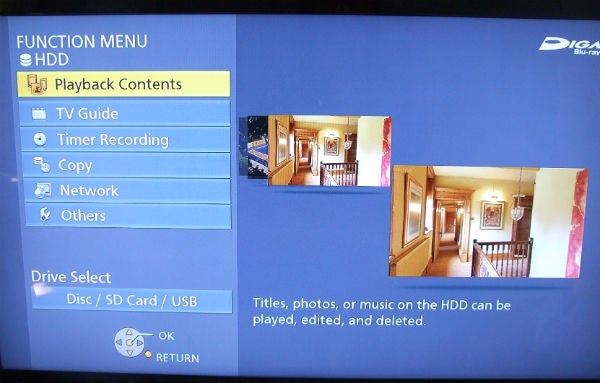
In terms of operation the DMR-HW100 is extremely easy to use. On-screen presentation is friendly, clean and uncomplicated, particularly the pivotal Direct Navigator and Functions menus. It helps that the architecture is identical to Panasonic’s Blu-ray decks. To-the-point dialogue boxes guide you when programmes clash for example, plus DLNA menus are straightforward and every screen makes good use of the coloured buttons on the remote. Showing two confirmation screens when setting a programme to record is a little excessive though.
The only thing that lets the side down is the EPG, which needs a revamp sharpish. It’s too cluttered to navigate comfortably, no thanks to the unnecessary grey box that’s supposed to display adverts but simply shows the ‘DIGA’ logo.
As a result the programme grid is squeezed up too much, allowing only the first few letters of each programme to be seen. The colour-coded legend at the bottom is helpful but overall it’s a poor design and makes you wonder how Samsung crammed in the same info and a live TV screen without making it feel half as cluttered.

Still, at least Panasonic’s remote is still up to scratch. It a colourful, chunky-buttoned affair with loud labels and the sort of layout that lets you navigate without having to gawp at the keys every two seconds.
Performance is excellent across the board. The quality of the deck’s high-definition pictures is stunning, no matter how challenging the material. We viewed Channel 4 HD’s coverage of the Athletics World Championships and the images are consistently sharp and steady.
Fine detail, like skin textures and crowds seated behind the action enjoy glorious clarity, while the coloured Lycra suits simply radiate from the screen. When reproducing sprinters, the box keeps pace with the objects without any discernible block noise or break-up.

We watched the same action in SD on regular Channel 4 and unbelievably the drop in quality isn’t as big as we’d imagined. Images retain a depth and crispness that make them enjoyable to watch, and despite the presence of a little extra mosquito noise here and there picture quality is generally smooth.
Any PVR worth its salt should be able to maintain this high level of picture quality when recording programmes, and thankfully the DMR-HW100 does just that. There’s no discernible difference between live and recorded pictures, which is exactly what you strive for. Without a Blu-ray or DVD drive on board there are no recording modes so you can’t lower quality to increase recording time.
Next up we checked the quality of web videos from YouTube and Dailymotion, which look decent and stream smoothly, although they appear a little fuzzy when blown up on a 40in screen.
Verdict
The DMR-HW100 is a formidable PVR proposition, melding all the essential Freeview HD features with a generous range of networking features and web content.
The only PVR that matches this level of functionality is Samsung’s BD-DT7800, but the Panasonic’s ability to record two channels simultaneously – something surprisingly that the Samsung can’t do – might make it a more attractive option to some buyers.
It’s worth pointing out though that the Samsung comes with built-in Wi-Fi, a better web portal and EPG, and a larger hard-disk drive (500GB), which makes it a better option on paper, but the ability to record two channels at once is arguably more beneficial on a day-to-day basis.
In any case, the DMR-HW100’s excellent picture quality, Skype support, 2D-to-3D conversion, USB and SD card ports, plus a comprehensive range of digital TV features make it a superb choice – just be sure to check out the Samsung before making your decision.
Trusted Score
Score in detail
-
Value 8
-
Features 8
-
Performance 9
-
Design 8

